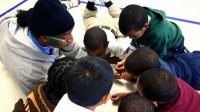Strategies for Getting Started with After-School SEL
Planning and fundraising tips to launch your own program, from the pro behind WINGS for Kids.
Your content has been saved!
Go to My Saved Content.WINGS for Kids has one very big asset in its quest to teach children good social and emotional skills: founder and CEO Ginny Deerin. Deerin earned decades of experience as a marketing executive and professional fundraiser before launching the after-school program in Charleston, South Carolina, in the late 1990s.
She is adamant, though, that you don't need a Ginny Deerin to undertake a similar effort at your school. "It's just a matter of having your act together and being willing to go and ask for what you need," she says.
Deerin and her colleagues aren't territorial about their methods at WINGS for Kids. They figure the more children who learn how to manage their emotions and make good choices, the better. So here are their tips for you on how to get started.
1. Survey the local after-school landscape.
Make a quick assessment of what's going on after school in your community, Deerin suggests. Is there already a great after-school program that you could try to partner with to integrate social and emotional learning (SEL)? Or is your best option -- keeping in mind that this is the more difficult route -- to create an independent program on your own?
2. Get informed about the research on effective SEL.
This will prepare you to make your case to parents, funders, and potential partners. WINGS recommends checking out the information at the Collaborative for Academic, Social, and Emotional Learning (CASEL), Educators for Social Responsibility (ESR), and their own WINGS for Kids site. (Editor's note: Edutopia's social and emotional learning page could be useful too.)
3. Define a set of learning objectives.
Armed with your new knowledge of SEL, articulate exactly which skills you want children to gain in your program. For models, you can look at the WINGS for Kids objectives ( 107K) or the Illinois state standards for SEL.
4. Design the structure of your program.
Plan out the components of your program and its daily schedule. Consider what kinds of activities you want to weave social and emotional lessons into. If you're partnering with an existing after-school program, you'll do this in collaboration with that program. Deerin recommends that you create a fairly consistent schedule from day to day; this gives children the comfort of a routine and also creates regular time slots when community members can volunteer their services. For instance, the WINGS program structure ( 50K) includes Choice Time activities that run at regular hours for nine weeks at a stretch, which makes it easy for a local artist, chef, or athlete to visit and teach. (A caveat: Staff your program adequately to run without volunteers, Deerin says, so that when an outsider comes in, a staffer can facilitate the lesson.)
5. Build a menu of activities and lesson plans.
At WINGS, children learn social and emotional lessons through fun activities. You can tap into free online resources for ideas of how to do that. WINGS suggests these sources for learning activities: their own Hot WINGS library, PBS Parents, and ESR's Adventures in Peacemaking.
6. Plan a strategy for training and evaluating staff.
This is the single most important thing you can do, Deerin says. She explains, "If you could do only one thing, forget about learning objectives and all that stuff. Get your staff more socially and emotionally smart, because then they'll model it." WINGS recruits local college students as teachers and trains them for 40 hours in the summer and another 20 hours during the year. They've shared some of their training documents on our Resources & Downloads page. The WINGS teachers keep detailed logs of their interactions with students in an online data system, which supervisors use to evaluate the teachers and ensure quality.
Doing less than that will get you the equivalent of WINGS light, says Deerin. "But I think some is better than none. Taking steps to weave SEL into an after-school program is a really positive thing."
7. Nurture your partnerships.
First and foremost, nurture your biggest partnership, the one with the after-school program or school that hosts you. Be clear about what you're teaching, how you're teaching it, and who is responsible for what. Then look for additional partners. Deerin suggests you figure out what the kids like to do and who in your community is doing that -- say, a dance studio, music school, or carpentry shop -- and pitch them on working with your program. Most organizations in the community want to help kids. For tips on how to present yourself, see number 8, below.
8. Do your homework for successful fundraising.
Fundraising needn't be intimidating, Deerin says. First, identify your prospects. Look for people and philanthropic organizations in your community who have an interest in helping children. Find out who donates to the local children's museum or Boy Scouts, for instance. Consider local foundations, churches, and civic clubs like Rotary. Next, get some time with them and be prepared to make a strong case, using evidence to back it up. Understand that you may get only one yes for every 20 people you ask, and that's OK. The same strategy applies to recruiting community partners.
For more useful information, Deerin suggests checking out Social Venture Partners International and the Foundation Center, two organizations that can help you find donors.
"It's real make-believe that you have to have movers and shakers behind your project to raise money," she says. "It isn't magic. You don't have to have fundraising experience. You just have to be willing to go out and persevere in getting yourself in front of people who are likely to have an interest in what you're doing."
